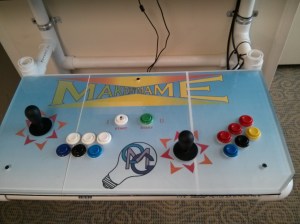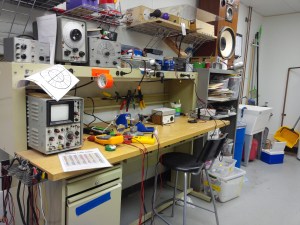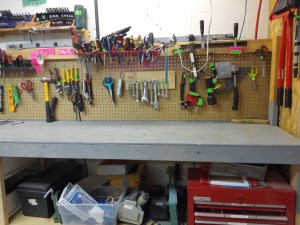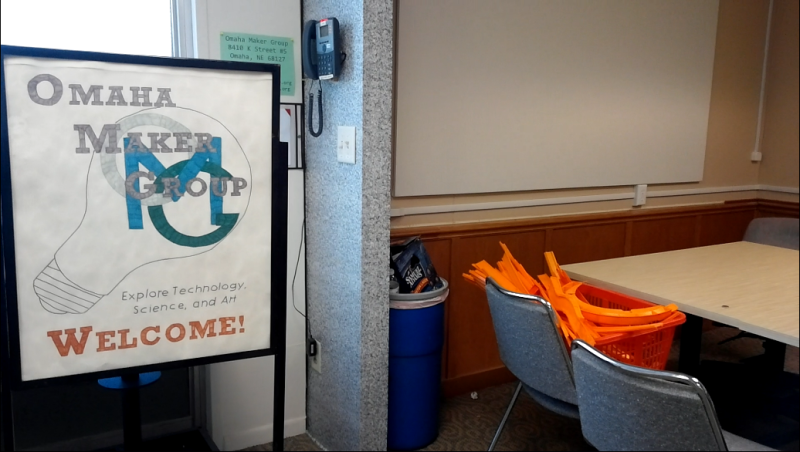Members of the [Omaha Maker Group] in Omaha, Nebraska affectionately call their space The Makery. This hearkens back to their humble beginnings in a 900 square foot space that formerly housed a bakery. There was one measly electrical outlet and they had to travel to the nearest restroom, often on vehicles they made. It was in this small space where they built the workbenches and forged the friendships that created the inviting hangout they have today.
[OMG] has been in their current, more centrally located space for the last two years. It was there that I met [Eric] and [Ben] for a few hours in the evening before Maker Faire, for which they are largely responsible. [Eric] had spent the day setting up at the Omaha Children’s Museum and he and [Ben] were kind enough to give me a detailed tour.
 The new space is a progression of rooms that begins with a combination lounge and meeting space. Here you’ll find the beer and snacks, the brag wall full of framed articles, and one of the remote controllable web cams. A few of the founding members have since flung themselves around the world, but are able to participate through these links. The best part of this room is either the PVC-framed Raspi MAME cabinet or the sign on the bathroom door which doesn’t discriminate against androids.
The new space is a progression of rooms that begins with a combination lounge and meeting space. Here you’ll find the beer and snacks, the brag wall full of framed articles, and one of the remote controllable web cams. A few of the founding members have since flung themselves around the world, but are able to participate through these links. The best part of this room is either the PVC-framed Raspi MAME cabinet or the sign on the bathroom door which doesn’t discriminate against androids.

Next up is a smallish room with their 3D printer, a modified Mendel with a spool holder made by one of the members. There’s a large pile of glue sticks next to it to help prints adhere to the bed. That was a new one to me. [Ben] says they work almost too well. Next to that is their K40 C02 laser cutter that they modified to operate only when closed (!). They’ve also added LEDs and an exhaust fan. The cutter was internally crowdfunded in about three days. This method works well for them according to [Eric]; no one spends money on equipment they won’t use. They are currently in the process of building a second, bigger one using a donated frame.
 Much of the magic happens in the next room. It’s the biggest and houses most of the general making space, including an electronics workbench and a separate bench with hand tools. In the center are some modular wheeled workbenches, which are the first things they made as a group in the old space. You’ll also find a sewing area, a hot wire foam cutter, a plotter, and the Shapeoko they won through Inventables’ 50 states contest.
Much of the magic happens in the next room. It’s the biggest and houses most of the general making space, including an electronics workbench and a separate bench with hand tools. In the center are some modular wheeled workbenches, which are the first things they made as a group in the old space. You’ll also find a sewing area, a hot wire foam cutter, a plotter, and the Shapeoko they won through Inventables’ 50 states contest.
They have a member who happens to be a machinist. He’s provided all kinds of fun things like a metal lathe, wood lathe, and jigsaw that are in the fourth and final room. This is where all the heavy machinery and a lot of the raw materials can be found, along with a mill, welding rigs, a drill press, a band saw, things of that nature.
 One of my favorite things about the space is the overall organization. [Eric] told me that they regularly schedule purge days to combat clutter. This is especially helpful when they have things like treadmills donated to them that are good for a couple of motors and are basically just in the way after that. All of the hand tools like socket wrenches, pliers, and hammers are color-coded to distinguish between those that anyone is free to use and those that are personal. Several shelves of blue storage totes function as lockers for private stashing.
One of my favorite things about the space is the overall organization. [Eric] told me that they regularly schedule purge days to combat clutter. This is especially helpful when they have things like treadmills donated to them that are good for a couple of motors and are basically just in the way after that. All of the hand tools like socket wrenches, pliers, and hammers are color-coded to distinguish between those that anyone is free to use and those that are personal. Several shelves of blue storage totes function as lockers for private stashing.
It’s great to see a group function the way that [Omaha Maker Group] does. In addition to organizing Omaha’s first Maker Faire, they regularly man a giant booth at the Nebraska Robotics Expo. They also hold competitions at least once a year for things like trebuchet and egg drop engineering. Earlier in 2014, they had a FirLumber rally and built their own wood car run inside the ‘space.
They try to keep membership at reasonable rates. For the $15 a month student rate, you can use the publicly available tools and machines. $35 per month will get you a key. Either way, beer in the fridge is always appreciated. They have open shop time at least twice per week and meet monthly to discuss business. If you’re not into hardware, they also have a programming subgroup called OMGCode.
[wpvideo bmv5hhpU]
[wpvideo LVjeLrXk]





























I use glue sticks :)
Why do people keep on using Raspberry Pies as the basis of MAME machines? Do they not realise that the Pi is a pretty terrible platform for MAME?
What’s better? (read, as cheap and works better)
i already have a HTPC 24h on. so i just added wireless controllers.
can play pretty much anything. and do not need an extra display. also playing on the main widescreen in the house tv is nice for for those games that uses two 4:3 screens.
An HTPC isn’t as cheap as a Ras-Pi, unfortunately.
I have been using the iCade ’60 in one’ (JAMMA) for the retro game cabinets and I was thinking of using PiPlay / PiMane on the Raspberry Pi instead.
The old retro games ran on hardware that was 1 MIPS or less so in theory a Raspberry Pi should be more than enough.
I won’t use PC based hardware as it is far too unreliable for this sort of thing – too many connectors for dust to get into, too much air flow required and too greater sensitivity to shock and vibration.
So I ask, why do you think the Raspberry Pi is a terrible platform for this and what would you suggest as an alternative?
Thanks in advance.
Actually, you’d be amazed how many arcade machines run cheap, PC based hardware nowadays. Consumer PC hardware (with a decent fan setup/cards screwed in properly) is actually more stable than you think.
The main issue I have with the Pi as a MAME box is that you will be surprised at what runs well and what doesn’t. For example, you might find Street Fighter II runs ok, but Asteroids doesn’t. This is due to MAME choosing to go for emulation accuracy over speed, also analogue sound emulation is hard to do ;-)
Due to the above reasons, Pi MAME builds are based on old versions of MAME, which means it’s a pain trying to get the correct ROM versions.
Personally, if you have a large enough cabinet, just grab a $50 3yr old PC and use that instead.
What version of PiMame did you try. I am still keen to give it a go.
It’s probably a location thing I have with PC’s. Here it is hot and humid. The heat causes more air flow and the humidity causes the dust to stick. After only three months my desktop PC will have a solid disk of dust between the Fan and CPU heatsink.
Its still better than iOS.
Made me think of a sign with a sitting man with a light bulb above his head followed by a sitting woman with a light bulb above her head and then a sitting android pooping out a light bulb.